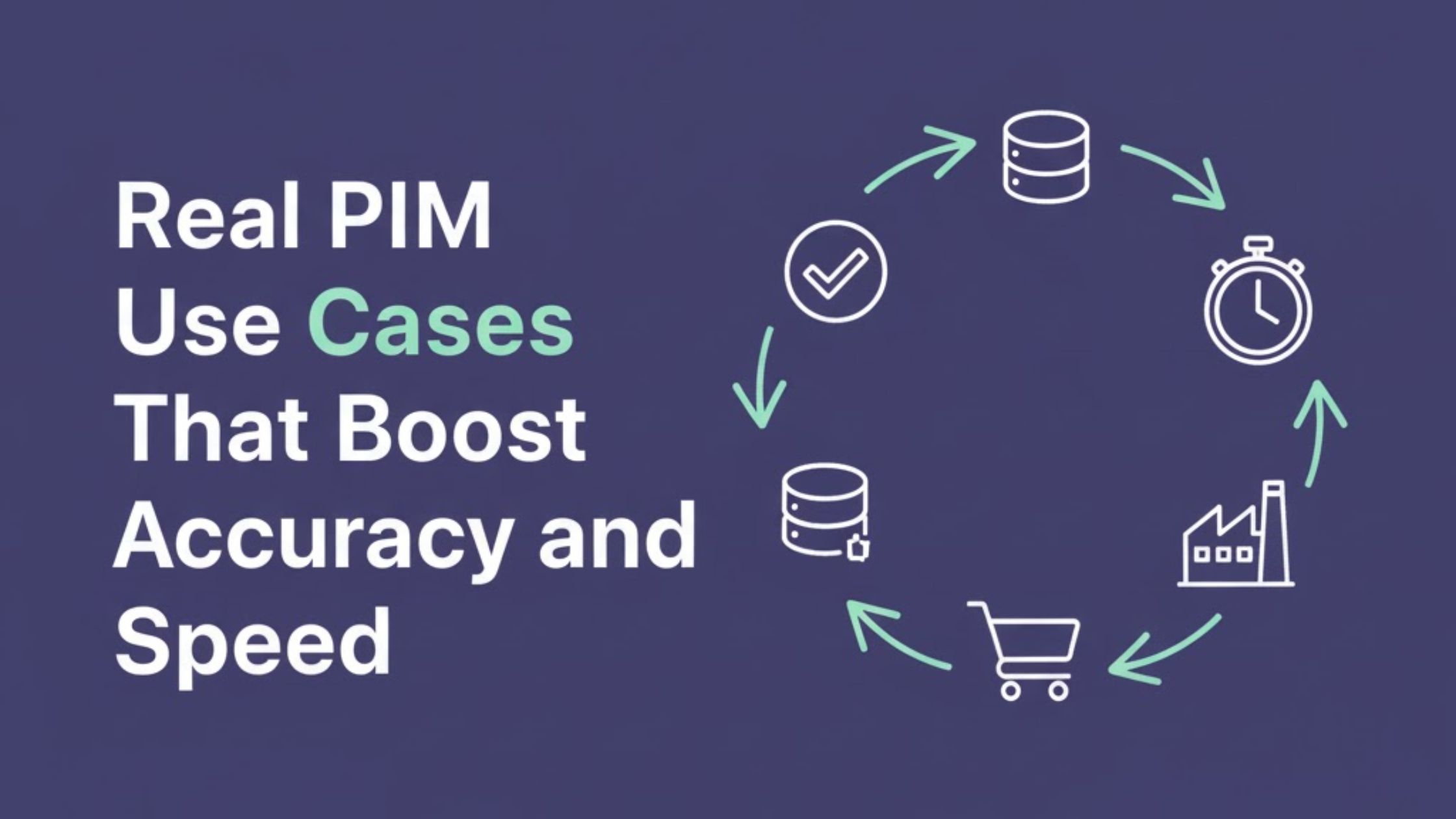Real PIM Use Cases That Boost Accuracy and Speed

Real PIM Use Cases That Boost Accuracy and Speed
Managing product information effectively is a critical challenge for businesses operating across multiple sales channels.
A modern Product Information Management (PIM) platform enables companies to centralize, enrich, and distribute product data efficiently. By adopting a PIM solution, organizations can improve data accuracy, streamline processes, and accelerate time-to-market.
This article explores real-world PIM use cases that deliver measurable benefits, helping businesses enhance operational efficiency and customer satisfaction.
Table of Key PIM Use Cases
Moving forward, we’ll be looking at the most common PIM use cases in detail:
Centralized Product Catalog Management
Centralizing product data is one of the foundational benefits of a PIM system. Businesses often face fragmented data across spreadsheets, ERPs, and multiple teams, which leads to inconsistencies and errors.
Benefits include:
- Single source of truth for all product information.
- Reduced duplication and errors.
- Easier updates and catalog maintenance.
Multi-Channel Product Distribution
Selling across e-commerce platforms, marketplaces, retail partners, and mobile apps requires consistent product information.
PIM systems ensure seamless distribution by:
- Maintaining uniform product data across all channels.
- Automating updates to prevent errors.
- Supporting a consistent customer experience.
E-Commerce Platform Integration
Integrating PIM with e-commerce platforms such as Shopify, Magento, or Salesforce Commerce Cloud ensures that product information is always accurate. Real-time synchronization reduces errors, accelerates product launches, and improves customer trust.
Marketplace Listing Optimization
Selling on marketplaces requires precise, platform-specific product information. PIM systems allow businesses to:
- Customize listings according to channel requirements.
- Include optimized descriptions, images, and specifications.
- Enhance visibility, compliance, and sales performance.
Product Data Enrichment
PIM platforms enable businesses to enrich products with images, videos, specifications, and marketing content.
Benefits include:
- Improved customer engagement.
- Reduced post-sale inquiries.
- Consistency across channels.
Digital Asset Management
A centralized digital asset library ensures marketing and sales teams have quick access to approved images, videos, and manuals. This reduces bottlenecks and maintains brand consistency.
Localization and Translation
Expanding globally requires accurate multilingual product data.
PIM systems:
- Automate translations.
- Manage cultural localization.
- Ensure compliance with local regulations.
Price and Inventory Synchronization
PIM systems integrate with ERP and inventory tools to keep pricing and stock consistent across all channels. Real-time updates:
- Prevent overselling.
- Enable dynamic pricing.
- Increase customer satisfaction.
Product Lifecycle Management
Tracking products from development to retirement is simplified with PIM systems. Businesses gain visibility, reduce inefficiencies, and ensure timely updates.
Compliance and Regulatory Reporting
PIM ensures all product information meets regulatory requirements. Automated reporting reduces risk, increases accuracy, and builds stakeholder trust.
Marketing Content Personalization
Leveraging enriched product data allows personalized marketing campaigns, boosting engagement, conversion rates, and brand loyalty.
Analytics and Reporting on Product Performance
PIM platforms provide insights into product performance, enabling better decision-making, merchandising strategies, and inventory planning.
Automated Product Feed Generation
Generating feeds for multiple channels becomes effortless with PIM. Automation ensures:
- Correct, optimized information.
- Faster distribution.
- Reduced manual errors.
Supplier and Vendor Data Management
Centralizing supplier and vendor data improves collaboration, accuracy, and accelerates new product onboarding.
Streamlined Onboarding of New Products
Templates, validation checks, and automated workflows ensure new products are launched quickly and accurately.
Omnichannel Retail Management
A PIM system provides a unified view of all channels, enhancing brand consistency, customer loyalty, and operational efficiency.
Improving Data Quality and Consistency
Validation, enrichment, and duplicate checks maintain high-quality product information, reducing errors and supporting better business decisions.
Enhancing Customer Experience Through Accurate Product Information
Accurate, complete, and consistent product data builds customer trust, reduces returns, and enhances the overall shopping experience.
Supporting Sales and Merchandising Strategies
Providing accurate product information supports sales campaigns, promotions, and merchandising strategies, increasing revenue and marketing effectiveness.
Reducing Manual Data Entry Errors
Automation minimizes repetitive tasks, reduces errors, and frees teams to focus on strategic initiatives.
Unlock the Full Potential of Your Product Data with PIM
A modern PIM platform transforms product information management by centralizing data, enriching content, and automating workflows.
Businesses that adopt PIM enjoy higher accuracy, faster product launches, and enhanced customer experiences. Real PIM use cases, from marketplace optimization to personalized marketing, demonstrate that investing in PIM is a strategic decision for growth and operational efficiency.
Other insights






